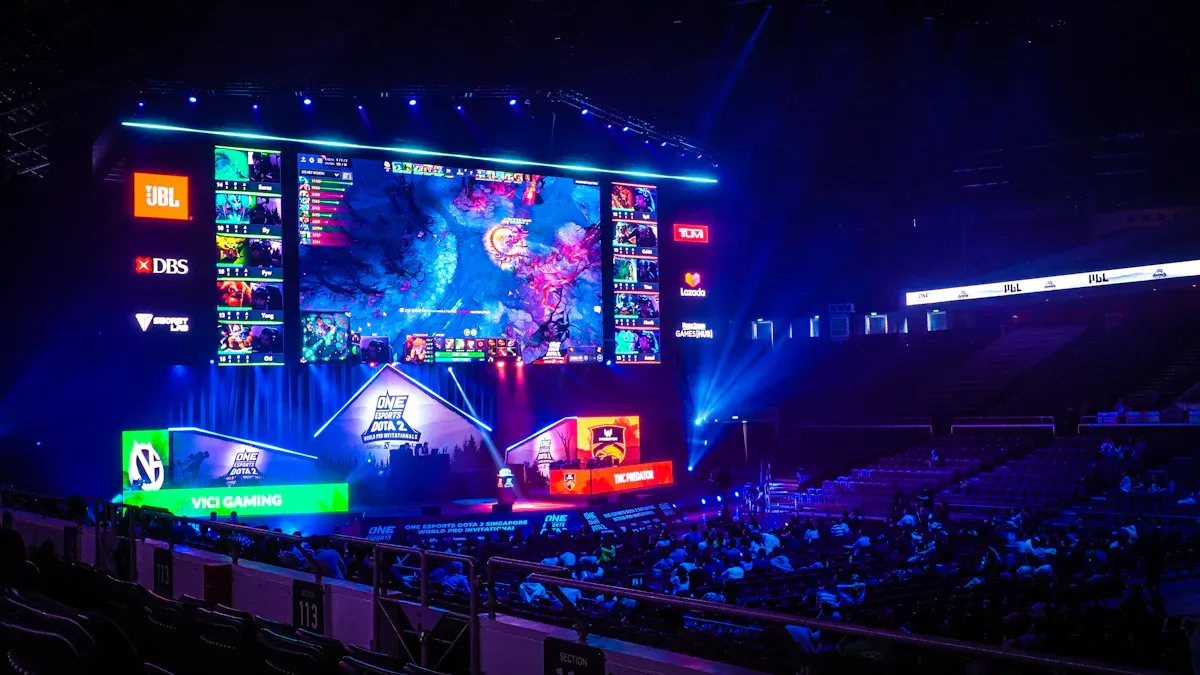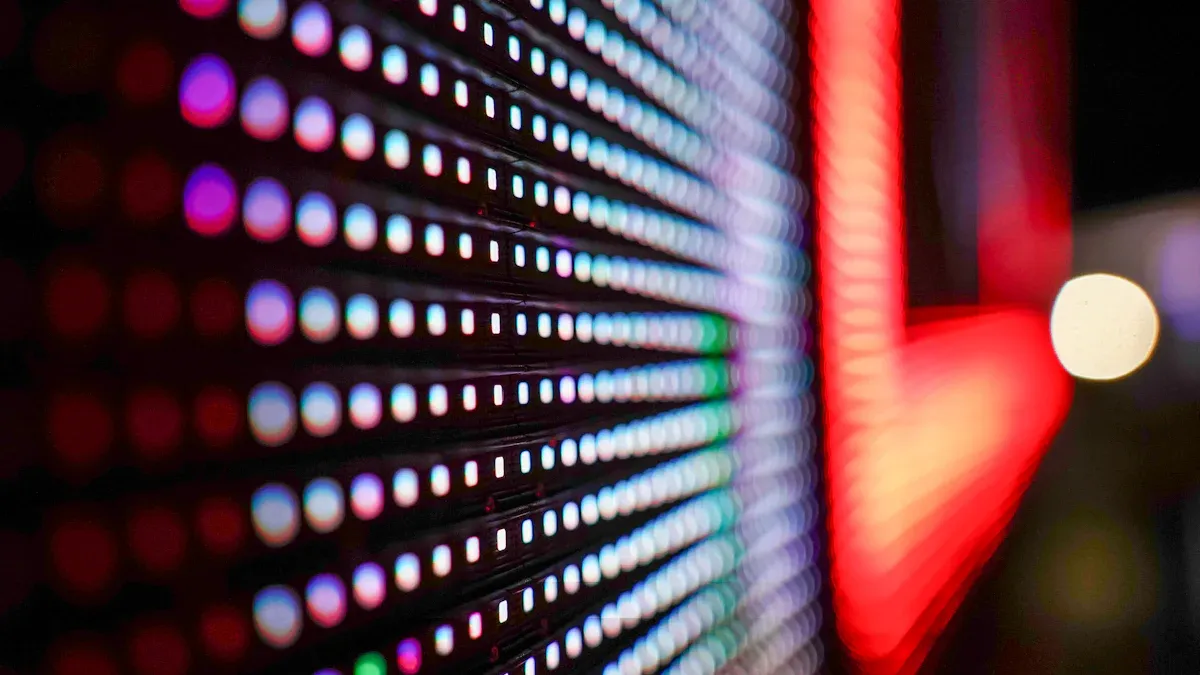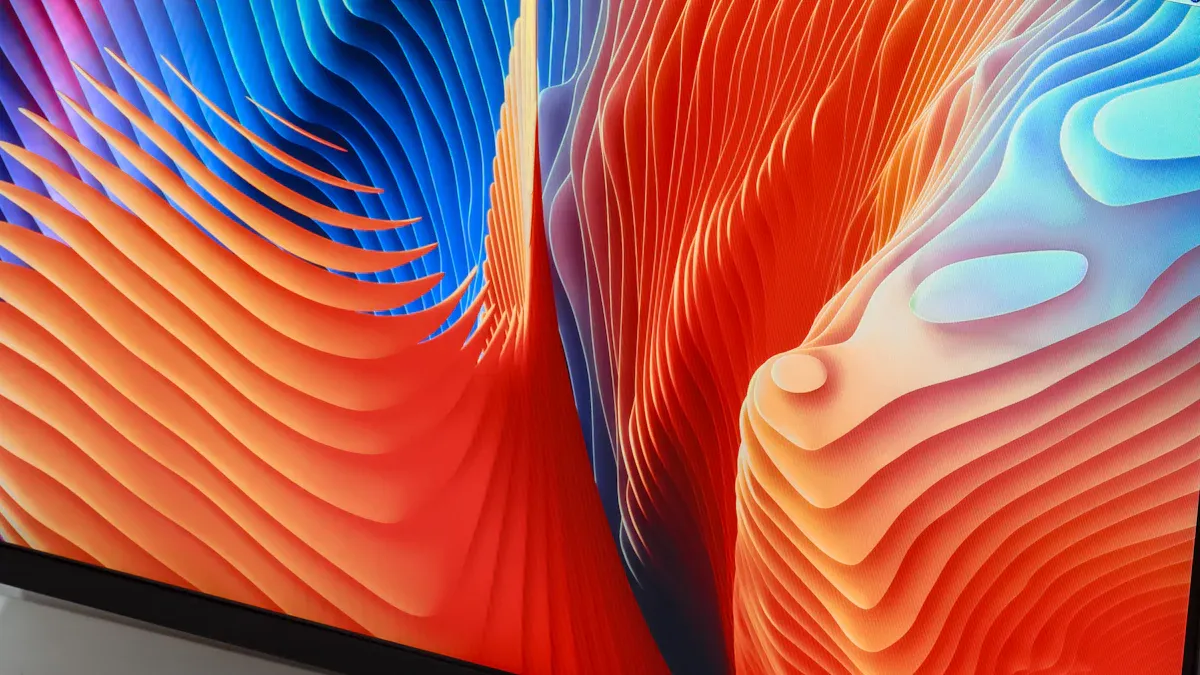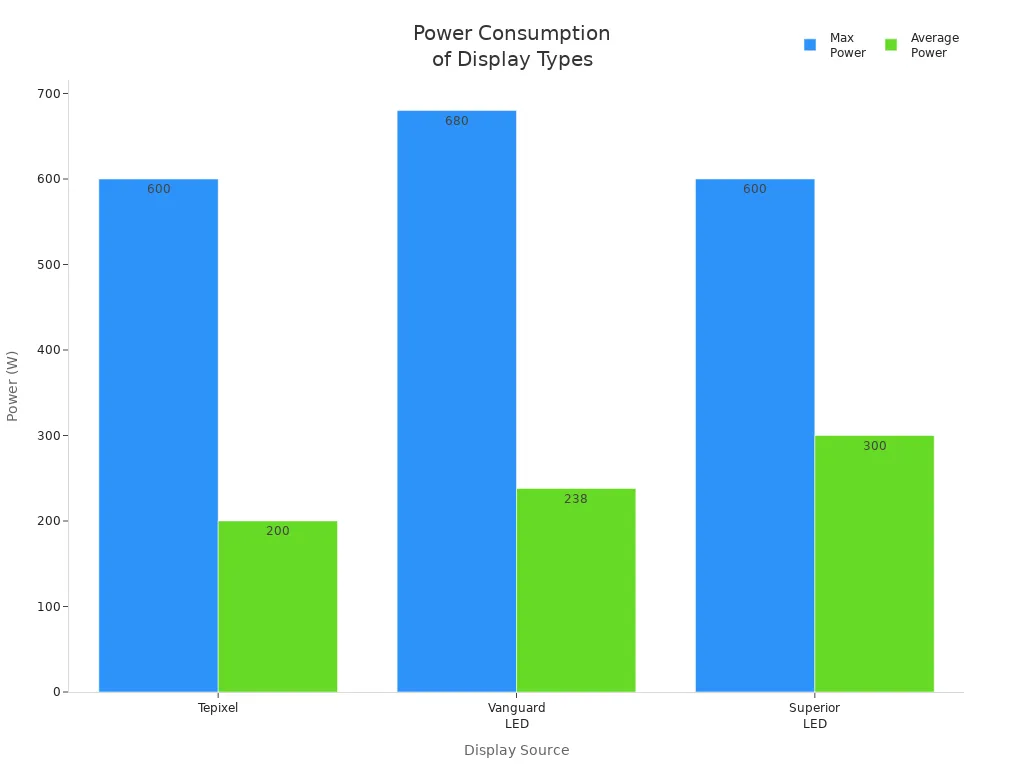How Do LCD Splicing Screens and LED Displays Differ

When you compare LCD splicing screens and LED displays, you notice clear differences in image quality, seamlessness, and installation options. LED displays offer high brightness and vibrant colors, making them suitable for outdoor and large indoor spaces. LCD splicing screens deliver sharp images but may show visible seams between panels. The LED splicing screen market is growing rapidly, expected to reach USD 4.2 Billion by 2030, while LCD splicing display walls also see steady growth.
Factor | LCD Splicing Screen | LED Display |
|---|---|---|
Image Quality | High pixel density, sharp | High brightness, vibrant |
Seamlessness | Visible seams | No seams |
Installation Flexibility | Good for small spaces | Versatile, various lighting |
Cost | Affordable upfront | Higher initial cost |
Key Takeaways
LED displays provide brighter images and vibrant colors, making them ideal for outdoor and high-light environments.
LCD splicing screens offer sharp visuals but may show visible seams, making them better suited for controlled indoor settings.
LED displays are more energy-efficient and have a longer lifespan, leading to lower long-term costs despite higher initial prices.
The modular design of LED displays allows for flexible installation in various shapes and sizes, perfect for large venues and creative projects.
For budget-conscious projects, LCD splicing screens offer a cost-effective solution while still delivering high-quality visuals.
Technology of Splicing Screen and LED Displays

LCD Splicing Screens Explained
You see lcd splicing screens in many control rooms, conference centers, and art exhibitions. These splicing screen systems use multiple lcd panels arranged together on a frame. Each panel aligns precisely, which helps minimize bezels and gaps. A central control system distributes video signals to every lcd panel, keeping the display synchronized. The control unit processes incoming signals, adjusting color, brightness, and alignment for each lcd. Advanced bezel compensation technology reduces the appearance of borders between panels. The synchronized system displays content across the entire splicing screen array, delivering high-resolution visuals.
BOE has made significant advancements in splicing screen technology. The company launched 55-inch and 46-inch 0.88mm bezel lcd splicing screens. The 46-inch model measures 1018.96mm in length and 573.55mm in width. This specification stands out because of its ultra-narrow bezel, which is only 0.88mm. You often find this type of lcd splicing screen in installations that require high definition and seamless integration, such as art exhibition displays. The small bezel allows for a nearly uninterrupted visual experience, making it ideal for environments where image quality and screen integration matter most.
Tip: If you need a display wall with high definition and minimal seams, lcd splicing screens with ultra-narrow bezels offer a practical solution.
LED Displays Overview
You encounter led displays in stadiums, shopping malls, and outdoor advertising. These displays use thousands of tiny led chips to produce images directly from light. Recent advancements have transformed led display technology. Micro-LED technology now offers higher brightness and lower power consumption. Manufacturers use new bonding methods, such as eutectic bonding, to improve reliability and yield. The PAM driving mode streamlines circuit design and boosts efficiency, especially at low grayscale levels.
Native RGB technology in led displays improves thermal compensation and luminous efficiency. Cost reduction strategies include increasing wafer usage and scaling substrate sizes. You also see transparent micro-LED displays in retail and architecture, providing higher brightness and better transparency than OLEDs. Fine-pitch led displays deliver higher resolution and better image quality, making them suitable for control rooms and places where clarity is essential. Transparent led displays create visually striking effects for modern spaces.
Micro-LED displays use tiny leds for brighter images and lower energy use.
Fine-pitch led displays provide sharp visuals for professional environments.
Transparent led displays enhance retail and architectural designs.
You benefit from led displays when you need vibrant colors, seamless visuals, and flexible installation options.
Key Differences in Display Quality

Brightness and Color Contrast
When you compare lcd splicing screens and led displays, you notice key differences in brightness and color contrast. Led displays stand out for their high brightness. This makes them perfect for environments with a lot of light, such as shopping malls or outdoor spaces. Led screen technology uses advanced backlighting, so you get images that stay clear and vibrant even in direct sunlight. Lcd splicing screens, on the other hand, offer good image quality but cannot match the brightness levels of led displays.
Led screens are much brighter than traditional lcd screens.
High brightness in led displays helps your content stand out in any lighting.
Lcd splicing screens work best in controlled indoor environments.
Color contrast also plays a big role in image quality. Led displays deliver deeper blacks and more vivid colors. You see this difference when you use a led screen for advertising or events. The colors pop and attract more attention. Lcd splicing screens provide sharp images, but the contrast may look lower, especially in bright rooms.
Metric | Description |
|---|---|
Brightness | High brightness makes advertising content more eye-catching, enhancing viewer engagement. |
Resolution | High-definition display effects improve clarity, attracting more attention from viewers. |
Adaptability | Flexibility in application scenarios allows for effective advertising in various environments. |
Note: Led displays are favored for their excellent display effects in busy areas, helping your message reach more people.
Bezel and Seamlessness
Seamlessness is another area where you see key differences between lcd splicing screens and led displays. Lcd splicing screens use multiple lcd panels joined together. Even with ultra-narrow bezels, you still notice thin lines where the panels meet. These bezels can distract viewers, especially when you display large images or videos across the entire splicing screen.
Led displays solve this problem. You can combine many led panels to create one seamless display. The gaps between panels are almost invisible. This seamlessness gives you a smooth, uninterrupted viewing experience. Users often say that led displays look like a single giant canvas. You can focus on the visuals without any distractions from seams.
Minimal bezel gaps for a continuous visual experience
Support for curved setups, which enhances immersion
Ability to create 360-degree backdrops for events
You benefit from led displays when you want high resolution and seamless splicing for flawless visuals. Bright, clear images captivate your audience and create immersive experiences. Lcd splicing screens still offer good image quality, but the visible bezels can limit the impact in some settings.
Energy Efficiency
Energy efficiency is a key factor when you choose between lcd splicing screens and led displays. Led displays use less power than lcd splicing screens. This lower energy consumption means you save money on electricity over time. Led screens also have a longer lifespan, so you spend less on replacements and maintenance.
Source | Average Power (W) | |
|---|---|---|
Tepixel | 600 | 200 |
Vanguard LED | 680 | 238 |
Superior LED | 600 | 300 |

When you look at the long-term costs, led displays offer more savings. They use less energy and last longer, which reduces your total cost of ownership. Lcd splicing screens may cost less at first, but their higher energy use and shorter lifespan can increase your expenses over time.
Feature | LED Displays | LCD Splicing Screens |
|---|---|---|
Energy Consumption | Lower energy consumption | Higher energy consumption |
Initial Investment | Higher initial cost | Lower initial cost |
Long-term Costs | Reduced electricity costs | Higher electricity costs |
Lifespan | Longer lifespan | Shorter lifespan |
Environmental Impact | Lower environmental impact | Higher environmental impact |
Tip: If you want to lower your energy bills and reduce your environmental impact, led displays are the better choice.
You may also notice some common complaints with both lcd splicing screens and led displays. Users sometimes report issues like flickering, low brightness, ghosting, or image tearing. These problems can affect image quality and viewer satisfaction. Regular maintenance and choosing high-quality products help reduce these issues.
Full-screen distortion, flickering, or image tearing
Low brightness or blurred image on display
Full-screen flickering or ghosting
Installation and Flexibility
Modular Design
When you look at modular design, you see big differences between lcd splicing screens and led displays. Lcd splicing screens use multiple lcd panels joined together. This design works well for small spaces like classrooms or meeting rooms. You can place each lcd screen close to the next, but the overall setup has limits. You cannot easily scale a splicing screen to cover a huge wall or create unusual shapes.
Led displays use a modular approach that gives you more options. You can connect many led panels to build a led screen as large as you need. This flexibility lets you create displays for stadiums, shopping malls, or even curved surfaces. Led displays work in many lighting conditions, so you can use them indoors or outdoors.
Feature | LCD Splicing Screens | LED Displays |
|---|---|---|
Adaptability | Good for small spaces | Works in various lighting conditions |
Installation Flexibility | Flexible design for close placement | |
Scalability | Limited for large setups | Easily scalable for big spaces |
Tip: If you want a display that can grow with your needs, led displays offer the best modular design.
Thickness and Weight
You should also consider thickness and weight when choosing between lcd splicing screens and led displays. Lcd splicing screens tend to be bulkier and heavier. Each lcd screen has a glass panel, backlight, and frame. This makes the whole splicing screen harder to move and install. You may need extra support or a strong wall to hold the weight.
Led displays use lightweight panels. You can transport and install a large led screen more easily. The modular led design means you can carry smaller pieces and assemble them on site. This reduces the risk of damage and speeds up installation. Led displays also allow for creative shapes and sizes, which is hard to achieve with lcd screens.
Feature | Large-format LED Displays | LCD Splicing Screens |
|---|---|---|
Transport | Modular, lightweight, easy to move | Bulkier, heavier, harder to move |
Installation | Flexible, adaptable methods | More complex, needs more effort |
Maintenance | Easy front or rear access | Often requires more effort |
Adaptability | Many shapes and sizes possible | Limited to fixed dimensions |
You get more flexibility with led displays. You can install a led screen almost anywhere, even in places where a heavy lcd splicing screen would not fit. This makes led displays a smart choice for creative projects or large public spaces.
Cost and Maintenance
Purchase Costs
When you compare the purchase costs of lcd splicing screens and led displays, you notice some important differences. Lcd splicing screens usually have a lower upfront price. You can buy a large lcd screen wall for less money than a similar-sized led screen. This makes lcd splicing screens a popular choice for offices, classrooms, and control rooms where you need a big display but want to save on costs.
Led displays often cost more at the start. The technology in a led screen is more advanced, and the panels are built to last longer. If you need a display for a large public space or outdoor area, you will likely pay more for a led screen. However, the higher initial cost of a led display can pay off over time because of its longer lifespan and lower maintenance needs.
Tip: If your project has a tight budget, lcd splicing screens offer a cost-effective solution for high-quality visuals.
Maintenance Needs
You should also think about the ongoing maintenance needs for both lcd splicing screens and led displays. Lcd screens need regular cleaning and may require repairs if a panel fails. The backlight in an lcd screen can wear out, which means you might need to replace parts sooner. Led displays, on the other hand, are built for heavy use and have fewer parts that wear out quickly.
Energy efficiency plays a big role in long-term costs. Led displays use less power than lcd splicing screens, so you save money on electricity. This makes a led screen a smart choice for places where the display runs all day. You also help the environment by using less energy.
Service life is another key factor. Here is a quick comparison:
Display Type | |
|---|---|
LED Displays | 100,000 |
LCD Splicing Screens | 60,000 |
A led display can last up to 100,000 hours, while an lcd splicing screen usually lasts about 60,000 hours. This means you will replace lcd screens more often than led screens. Over time, the longer lifespan and lower energy use of a led screen can make it the better value, even if you pay more at first.
Note: Choosing a led display can reduce your maintenance work and lower your total cost of ownership.
Best Uses for LED Screen and LCD Splicing Screens
Ideal Scenarios for Splicing Screens
You often see lcd splicing screens in places where clear visuals and flexible layouts matter most. These displays work well in control rooms, conference centers, and collaborative workspaces. You can create a large display area by joining several lcd panels, which helps you monitor many sources at once or share detailed information with a team.
Here is a table showing where lcd splicing screens are most commonly used:
Environment Type | Example Use Case | Location |
|---|---|---|
Retail | Shake Shack uses LCD video walls to enhance dining experience and brand awareness | Hong Kong |
Professional Services | Monitoring company integrates LCD video wall for improved monitoring environment | Uganda |
Educational Institutions | HDFocus video wall enhances immersive work experience in a yacht company | Miami, USA |
Collaborative Workspaces | LCD video wall optimizes team collaboration in a company | Thailand |
Media Presentation | Fana TV enhances broadcast capabilities with LCD video wall | Ethiopia |
You benefit from lcd splicing screens in these settings because they offer:
High visibility, even in bright rooms
Large display areas for detailed content
Flexible and scalable layouts
High resolution for sharp images
You can also rely on lcd splicing screens for reliability and long service life. Many control rooms and conference spaces choose this type of display for its wide viewing angles and ability to show different types of content at the same time.
Tip: If you need a display for teamwork, monitoring, or presentations, a splicing screen gives you the flexibility and clarity you want.
Ideal Scenarios for LED Screen
You find led screens in places that need bright, seamless visuals and flexible installation. Led displays work best in large venues, outdoor spaces, and areas with changing light. You can build a led screen in almost any size or shape, which makes it perfect for stadiums, concerts, and public events.
Common venues and applications for led displays include:
Sports events and stadiums
Concerts and entertainment venues
Corporate events and branding
Outdoor advertising and public information displays
Retail spaces for attracting customer attention
A led screen stands out because it delivers high brightness and vibrant colors, even in direct sunlight. You can use a led display for live broadcasts, dynamic ads, or large-scale presentations. The seamless design means you get a smooth image with no visible gaps, which is important for immersive experiences.
You also save energy with led displays, and you can install them in creative ways, such as curved or transparent setups. This makes led screens a smart choice for modern, high-impact environments.
Note: Choose a led screen when you need a display that grabs attention, works in any lighting, and offers endless design options.
You can see the main differences between lcd splicing screens and led displays in their technology, visual performance, installation, and cost. The table below highlights these differences:
Category | LCD Splicing Screens | LED Displays |
|---|---|---|
Working Principle | Needs backlight for pixels | Each pixel emits its own light |
Display Effect | Natural colors, less eye fatigue | Vivid, high contrast, seamless |
Power Consumption | Higher | Lower, more efficient |
Application | Best for indoor, close viewing | Works indoors and outdoors |
If you want a splicing screen for a control room or meeting space, lcd splicing screens offer sharp images and lower upfront costs. For outdoor or high-brightness areas, led displays give you vivid visuals and flexible installation. Think about your space, budget, and what you expect from your display before you decide.
FAQ
What is the main difference between LCD splicing screens and LED displays?
You see the biggest difference in how each screen creates images. LCD splicing screens use backlights and liquid crystals. LED displays use tiny lights for each pixel. This makes LED displays brighter and more seamless.
Can I use LCD splicing screens outdoors?
You should not use LCD splicing screens outdoors. They work best indoors because sunlight can reduce their brightness. LED displays handle outdoor light much better and stay visible in direct sunlight.
Which display type lasts longer?
LED displays usually last longer. You can expect up to 100,000 hours of use. LCD splicing screens often last about 60,000 hours. This means you replace LCD screens more often.
Are LED displays more energy efficient than LCD splicing screens?
Yes, LED displays use less power. You save on electricity bills over time. LED screens also create less heat, which helps lower cooling costs in large spaces.
Do LCD splicing screens have better viewing angles than LED displays?
You get wider viewing angles with LCD splicing screens. This makes them a good choice for meeting rooms or control centers where people view the screen from different positions.
See Also
Understanding The Key Differences Between OLED And LED Displays
Selecting The Right Video Wall: LED Or LCD For You
A Simple Guide To Choosing Between LED And LCD Monitors
Top Software Solutions To Enhance Your LED Display Experience
Exploring The Functionality Of LCD Technology And Its Importance